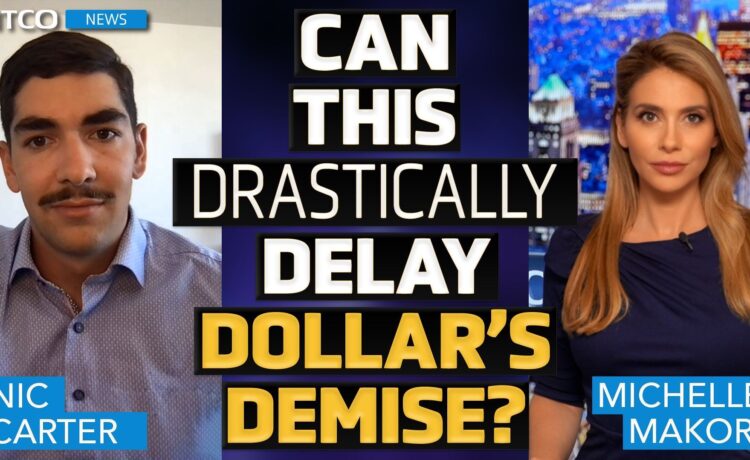(Kitco News) – With de-globalization and de-dollarization accelerating this year, this new market could extend the U.S. dollar’s lifespan as the world’s reserve currency, according to Nic Carter, founding partner at Castle Island Ventures and co-founder of Coin Metrics.
Stablecoins are a new market for the U.S. debt, Carter told Michelle Makori, Lead Anchor and Editor-in-Chief at Kitco News.
“We are at a critical nexus in the life of the dollar,” Carter said. “There have been some key events that have caused people to wonder if the dollar will remain the global reserve currency. We’re seeing the commodity market settle in local currencies, especially in connection with this new axis of Russia, India, and China. [For example,] 20% of oil transactions were settled in non-dollar currencies last year.”
In the latest developments, Russia and China have almost entirely de-dollarized when it comes to mutual trade. Foreign Minister Sergei Lavrov told local media this week that more than 90% of settlements are now done in national currencies. On top of that, bilateral trade between the two nations increased by 26% to $240 billion in 2023.
Carter views the crypto economy as a potential lifeline to the U.S. dollar’s reserve status. “The crypto economy is like an emerging nation. It’s a dollarized system. So it does support the dollar,” he said.
More specifically, Carter points to stablecoins creating new demand for dollar-denominated debt like the U.S. Treasuries.
“Stablecoin is a tokenized U.S. dollar representation that circulates on a public blockchain like Ethereum, Solana, and Tron. They were initially created because crypto traders were having a hard time settling their dollar transactions with exchanges. The crypto industry is notoriously unbanked.”
The two most prominent stablecoins are Tether’s USDT and Circle’s USDC.
“Stablecoins have become the medium of exchange for exchanges, the main collateral type on exchanges, and they’ve also broken out into sort of the non-crypto economy,” Carter noted.
Stablecoins are a new demand source for U.S. Treasuries because they are mainly backed by U.S. Treasuries. “Almost every stablecoin operates on this model whereby they hold Treasuries in reserve to back the dollar liabilities,” Carter explained. “That’s a meaningful buyer of U.S. debt.”
The current supply of stablecoins stands at more than $155 billion, with last year’s transaction settlements at $8 trillion, according to Coin Metrics.
“Each stablecoin is turning over 20 or 30 times a year. This year, I would forecast that stablecoin transactions would be over $10 trillion in settlement value, which is the same scale as Visa,” Carter pointed out. “It will become a very meaningful transactional medium and a very meaningful demand source for U.S. Treasuries.”
Who is buying U.S. debt?
The U.S. national debt has surged past $34.5 trillion, and according to Bloomberg Economics, future debt levels could spiral to 123% of GDP by the year 2034. That means the cost of managing that debt will be over one and a half times what the U.S. spent on national defense in 2023 and roughly the equivalent of the total budget for Social Security.
At the same time, the trend of foreign U.S. debt holders minimizing their exposure continues. “We are issuing a huge amount of debt at very high levels. And we rely on foreign buyers of the debt to keep our cost of servicing that debt low,” said Carter. “The question is, who is still a buyer of the U. S. debt? The two largest foreign holders of U.S. Treasuries are divesting — China and Japan are divesting. China used to have over a trillion in holdings. I think it’s down to the 600 billion range.”
The supply of stablecoins could hit $200 billion this year and $500 billion soon after, at which point, stablecoins would become a very meaningful holder of U.S. debt.
“Stablecoins extend the dollar’s reach globally, and they’re creating demand for Treasuries at a time when the U.S. government desperately needs to convince people to buy its debt,” Carter said. “Far from replacing the dollar, the crypto economy is actually highly supportive of the dollar system.”
Carter also made a point that there is a broader crypto-dollarization phenomenon happening in countries like Argentina, Nigeria, and Turkey. On what this means for the U.S. dollars, watch the video above.
He added that the emergence of stablecoins is similar to the emergence of eurodollars. For his comparison and its significance on the USD, watch the video above.
On the consequences of alarming levels of U.S. debt, the Federal Reserve’s next steps, and how Bitcoin fits into the picture, watch the video above.
Carter also shared his long-term Bitcoin price forecasts, the next big catalyst, its role in the financial ecosystem, and future innovations. Watch Part 2 of the interview here.
Disclaimer: The views expressed in this article are those of the author and may not reflect those of Kitco Metals Inc. The author has made every effort to ensure accuracy of information provided; however, neither Kitco Metals Inc. nor the author can guarantee such accuracy. This article is strictly for informational purposes only. It is not a solicitation to make any exchange in commodities, securities or other financial instruments. Kitco Metals Inc. and the author of this article do not accept culpability for losses and/ or damages arising from the use of this publication.
















